American Lobster Settlement Index | Update 2022
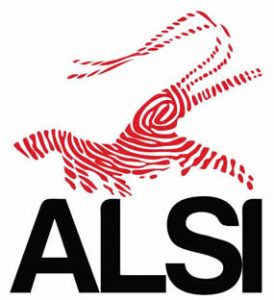 Compiled by: Rick Wahle, Andrew Goode and Kristyn Kleman
Compiled by: Rick Wahle, Andrew Goode and Kristyn Kleman
Participants: ME DMR (K. Reardon, R. Russell), MA DMF (D. Perry, T. Pugh), C. Brown (Ready Seafood Co.), J. Drouin (Little River Lobster Co.), RI DMF (S. Olszewski, C. McManus), NH F&G (J. Carloni), DFO Canada (A. Rondeau, N. Asselin, J. Gaudette, P. Lawton, S. Armsworthy, A. Cook), UNB, St. John (R. Rochette), PEIFA (L. Ramsay, M. Giffin), PEI DAF (R. MacMillan), Fishermen & Scientists Research Society (S. Scott-Tibbets), Memorial University (A. Le Bris)
American Lobster Settlement Index (ALSI)
The end of 2022 closed a stressful year for the US and Canadian lobster industry, but mostly for reasons unrelated to the size of the harvest or markets. The preoccupation in 2022 was on NOAA’s impending whale regulations, widely seen as an existential threat to the US lobster fishery. The Maine Lobstermen’s Association, together with Maine’s congressional delegation and Department of Marine Resources rallied to pass the US Federal Omnibus Spending Bill, the “December Miracle,” that now gives a 6 year pause for the industry and fishery managers to tool-up to meet those regulations while providing an infusion of research and relief dollars to address the many challenges ahead.
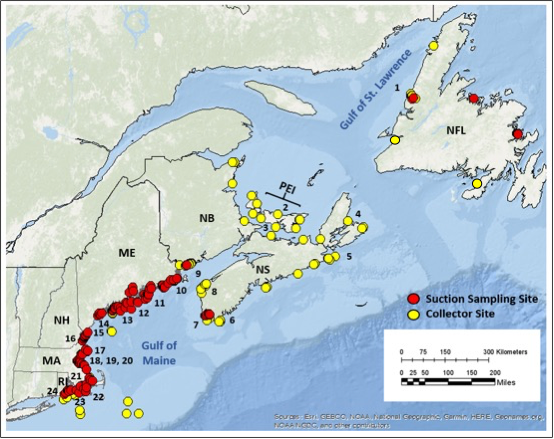 As for 2022 landings, Maine, Fundy and southwest Nova Scotia were all down in volume 8-9%, while Nova Scotia’s eastern shore, Quebec, and Newfoundland surged 8-26%! The southern Gulf of St. Lawrence and Massachusetts had yet to report. But dock prices plummeted from 2021’s record high, and for Maine that meant the modest 9% drop in volume translated to a 46% plunge in revenue.
As for 2022 landings, Maine, Fundy and southwest Nova Scotia were all down in volume 8-9%, while Nova Scotia’s eastern shore, Quebec, and Newfoundland surged 8-26%! The southern Gulf of St. Lawrence and Massachusetts had yet to report. But dock prices plummeted from 2021’s record high, and for Maine that meant the modest 9% drop in volume translated to a 46% plunge in revenue.
Meanwhile, with continuing declines in lobster recruitment in the US, the Atlantic States Marine Fisheries Commission approved Addendum XXVII, which will trigger a 1/8th of an inch (3.17 mm) increase in the minimum legal size of harvestable lobsters in Lobster Conservation Management Area 1 (Gulf of Maine) if the abundance of lobsters between 71-80 mm carapace length falls 35% or more below a reference level marked by the 2016-2018 average. Importantly, the Addendum acknowledges the predictive power of the ALSI index. Citing declines in settlement since 2012, it states that “persistent lower densities of settlement could foreshadow decline in recruitment and landings.” Indeed, following widespread declines in the settlement index (Figure 1), landings have declined 25% since their 2016 peak, and the Addendum’s trawl and ventless trap survey indices have reported a 23% decline in lobster recruitment. If the 35% threshold is reached, management actions will spread over 4 years to soften impacts of the gauge increase to the industry. Still, given the notoriously weak relationship between spawner abundance and subsequent recruitment, few expect the measure to reverse the downward trend so much as to provide a larger buffer than currently exists, a way to capitalize on high egg production while we have it.
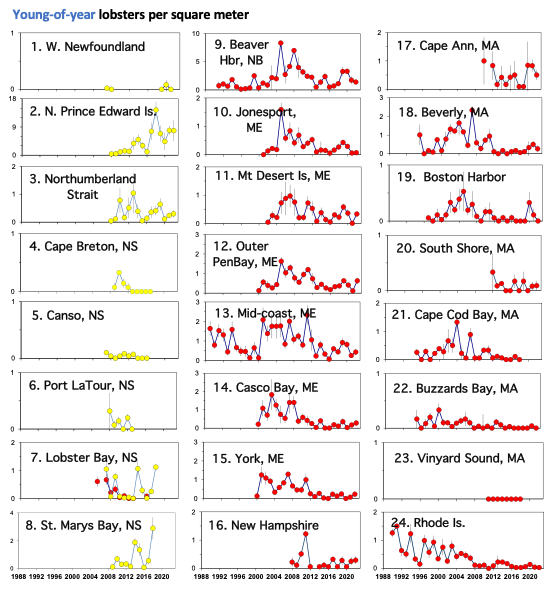
In that spirit, the Addendum also enacts a maximum harvestable size in Outer Cape Cod state waters, a measure already in effect for Federal permit holders of the Outer Cape Management Area. Now, all management areas in the US fishery have a maximum size limit, although it differs by area.
For the remainder of this Update, after recapping the 2022 lobster settlement season, we’ll turn to Jonah crabs, the other commercial species on the lobster-crab fishing license that hasn’t received much attention; and then we’ll close with a final note about ALSI’s changing of the guard.
Lobster Settlement 2022: ALSI’s intrepid sampling teams from southern New England to the Gulf of St. Lawrence forged through two years of the pandemic to maintain their much-valued continuous time series. Sampling in Cape Cod Bay remains on pause because of the now consistent presence of white sharks in the area during the fall survey. Newfoundland has also come to the end of its funding for settlement monitoring for now, and hopes are that they’ll resume in the near future as the frontier of the northwardly advancing lobster fishery.
In general, 2022 settlement remained stable relative to recent years (Figure 1). In the southern Gulf of St. Lawrence, the north shore of PEI and Northumberland Strait remained level, and New Brunswick’s Fundy shore and most of the Gulf of Maine stayed at historic lows. There was a local uptick along the mid-section of the Gulf of Maine from York to Mt. Desert Island, but the uptick we saw on the north shore of Massachusetts in 2021 didn’t persist for a second year. South of Cape Cod, settlement also remained at historic lows where it’s been for more than a decade. Not shown in these figures are the results of our industry-led deep-water collector surveys that provide critical insight on depth-wise patterns of settlement as they related to changes in the thermal regime along the coast and help refine our landings forecasts (see Update 2021). Suffice it to say that 2022 was on par with previous years.
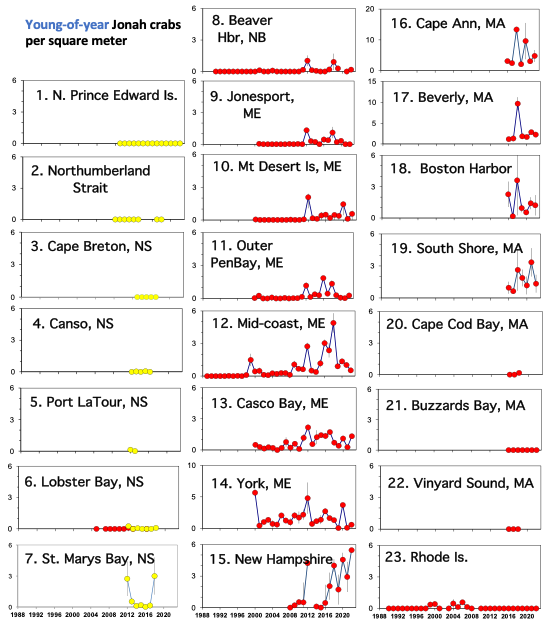
Jonah crab boom: To some harvesters, the Jonah crab (Cancer borealis) fishery may be the poor cousin to lobster, but it’s important nonetheless. Unlike the iconic, well-studied fisheries, until recently (2015) the Jonah crab has not had a formal fishery management plan, owing in part to the lack of survey data needed to conduct a stock assessment. The ALSI monitoring program has been helping fill that gap by collecting data on the early benthic stages of Jonah crab as far back as 1989. Back then Jonah crabs were sparse in coastal lobster nurseries, but in the late 1990s and early 2000s they started to appear, and then became prevalent, spreading northeast all the while (Figure 2).
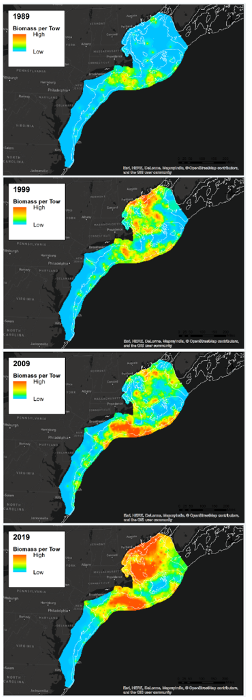
This pattern is mirrored in NOAA’s trawl data as depicted by the OceanAdapt web dashboard hosted by Rutgers University. In recent years the crabs have become widespread and abundant in the Gulf of Maine. Indeed, Jonah crab landings in New England have soared from less than 1000 metric tons (MT) prior to 1990 to more than 8000 MT in recent years. But they appear to reach their northern limit there. Neither the ALSI survey or OceanAdapt database have detected Jonah crabs on the outer coast of Nova Scotia or the Gulf of St. Lawrence; nor are Jonah crab landings reported on Canada’s Department of Fisheries and Oceans website.
Much remains to be learned about Jonah crab life history. Recent studies are providing valuable data on growth rates, size-at-age and maturity, that will inform future stock assessments. In short, ALSI may prove as useful forthe crab assessment as it is for lobster.
And the final note: This year, 2023, will mark ALSI’s 35th anniversary. After a good run, Rick is retiring on September 1st! From here on, Andrew will be curating the ALSI database and deep-water collector project. A huge thank you to the ALSI partners – fishing industry, government agencies, and academia – for their enduring support.
